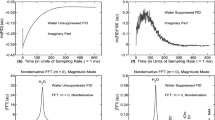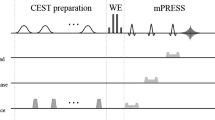Abstract
Object
Non-water-suppressed MRSI (magnetic resonance spectroscopy imaging) offers a number of advantages; however, spectra are hampered by the sideband artifacts. The origin of those is associated with the vibration of the gradient coils, and most of the sidebands are assumed to be related to the crusher gradients. The aim was to examine the dependency between the physical direction of the crushers and the sidebands. Additionally, the possibilities of optimization of the point resolved spectroscopy sequence (PRESS) were investigated.
Materials and methods
For the assessment of the sidebands, spectra at short echo time (TE) were collected at 3 T from standard water phantom. A homemade agar phantom was used to test the optimal strength of the crusher gradients. Optimized PRESS sequence was tested in vivo.
Results
The greatest sidebands were found to be associated with the crusher gradient in x-direction. Agar phantom and in vivo measurements revealed that reduction of the crusher’s strength to 5 mT/m could provide a significant minimization of the sidebands without raising the unwanted signals produced by volume selection.
Conclusion
This study demonstrates that crusher gradients in different directions produce a unique pattern of the sidebands. Moreover, optimization of the strength of crushers has been found to decrease sidebands so, the remaining part could be reduced in postprocessing.





Similar content being viewed by others
References
Van der Veen J, Weinberger DR, Tedeschi G, Frank JA, Duyn JH (2000) Proton MR spectroscopic imaging without water suppression. Radiology 217:296–300
Hurd RE, Gurr D, Sailasuta N (1998) Proton spectroscopy without water suppression: the oversampled J-resolved experiment. Magn Reson Med 40:343–347
Clayton DB, Elliott MA, Leigh JS, Lenkinski RE (2001) 1H spectroscopy without solvent suppression: characterization of signal modulations at short echo times. J Magn Reson 153:203–209
Clayton DB, Elliott MA, Leigh JS, Lenkinski RE (2001) Characterization of gradient- induced signal modulations: implications for proton MR spectroscopic methods. In: Proceedings of the 9th scientific meeting, International Society of Magnetic Resonance in medicine, Glasgow, p 58
Serrai H, Senhadji Clayton DB, Zuo C, Lenkinski RE (2001) Water modeled signal removal and data quantification in localized MR spectroscopy using a time-scale postacquisition method. J Magn Reson 149:45–51
Serrai H, Clayton DB, Senhadji L, Zuo Ch, Lenkinski RE (2002) Localized proton spectroscopy without water suppression: removal of gradient induced frequency modulations by modulus signal selection. J Magn Reson 154:53–59
Dong Z, Dreher W, Leibfritz D (2004) Experimental method to eliminate frequency modulation sidebands in localized in vivo 1H MR spectra acquired without water suppression. Magn Reson Med 51:602–606
Nixon TW, McIntyre S, Rothman DL, de Graaf RA (2008) Compensation of gradient-induced magnetic field perturbations. J Magn Reson 192:209–217
Chadzynski GL, Klose U (2010) Chemical shift imaging without water suppression at 3 T. Magn Reson Imaging 28:669–675
Dong Z, Dreher W, Leibfritz D (2006) Toward quantitative short-echo-time in vivo proton spectroscopy without water suppression. Magn Reson Med 55:1441–1446
Wu Y, Chronik BA, Bowen C, Mechefske CK, Rutt BK (2000) Gradient-induced acoustic and magnetic field fluctuations in a 4T whole-body MR imager. Magn Reson Med 44:532–536
Yao GZ, Mechefske CK, Rutt BK (2004) Characterization of vibration and acoustic noise in a gradient-coil insert. Magn Reson Mater Phy 17:12–27
Clayton DB, Elliott ME, Lenkinski RE (1999) In vivo proton MRS of the human brain at 4T without solvent suppression. In: Proceedings of the 7th scientific meeting, International Society of Magnetic Resonance in medicine, Philadelphia, p 1602
Bolan PJ, DelaBarre L, Baker EH, Merkle H, Everson LI, Yee D, Garwood M (2002) Eliminating spurious lipid sidebands in 1H MRS of breast lesions. Magn Reson Med 48:215–222
Elliott M, Clayton D, Lenkinski R (2001) 1H Spectroscopy without water suppression: removal of sideband modulation at short TE. In: Proceedings of the 9th scientific meeting, International Society of Magnetic Resonance in Medicine, Glasgow, p 1667
Ozdemir MS, De Denee Y, Achten E, D’Asseler Y, Lemahieu I (2007) Quantitative proton magnetic resonance spectroscopy in the presence of sidebands. IEEE Int Symp Biomed Imaging 4:1008–1011
MacMillan EL, Chong DGQ, Dreher W, Henning A, Boesh C, Kreis R (2011) Magnetization exchange with water and T1 relaxation of the downfield resonances in human brain spectra at 3.0 T. Magn Reson Med 65:1239–1246
De Graaf R (1998) In vivo NMR spectroscopy principles and techniques. John Wiley & Sons Ltd, Baffins Lane
Zhou XJ (2004) Crusher gradients. In: Bernstein MA, King KF, Zhou XJ (eds) Handbook of MRI pulse sequences. Elsevier Inc, Burlington, pp 305–316
Groger A, Chadzynski G, Godau J, Berg D, Klose U (2011) Three-dimensional magnetic resonance spectroscopic imaging in the substantia nigra of healthy controls and patients with Parkinson’s disease. Eur Radiol 21:1962–1969
Acknowledgments
The authors would like to acknowledge Alessandro Greco, Dominik Zietlow, Clemens Beeken and Mario Jendrossek from the Kepler-Gymnasium in Tuebingen for their help during the measurements. Their work was done as a part of a scientific project founded by the German Research Foundation (DFG KL 1073/7-1). This study was supported by the German Research Foundation (DFG KL 1073/7-1).
Author information
Authors and Affiliations
Corresponding author
Rights and permissions
About this article
Cite this article
Chadzynski, G.L., Klose, U. Proton CSI without solvent suppression with strongly reduced field gradient related sideband artifacts. Magn Reson Mater Phy 26, 183–192 (2013). https://doi.org/10.1007/s10334-012-0338-3
Received:
Revised:
Accepted:
Published:
Issue Date:
DOI: https://doi.org/10.1007/s10334-012-0338-3




